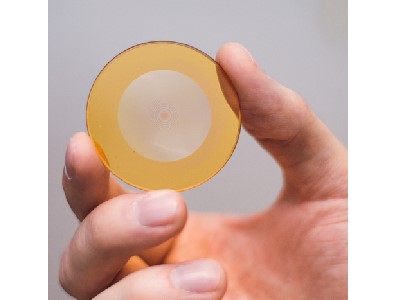Diffractive Optics to Reduce Mass of Satellite-based High-resolution Imaging Systems by 100 Times

When manufacturing a 256-level diffraction harmonic lens, photoresist with a thickness of 7 μm is applied to the surface of silica glass. Using laser light, a 256-level relief is drawn on the resist. Production of a single lens takes about half an hour. Compensation of image distortions is done by the digital processing of images using extremely precise neuron networks. (Image: Samara National Research University)
A group of scientists of Samara National Research University (Samara, Russia) are creating ultralight diffractive optics for use in high-resolution satellite-based imagers that will reduce optical-system mass by a factor of 100.
The researchers developed techniques for manufacturing a 256 layer diffraction harmonic lens, as well as the algorithms for reconstructing the obtained images. This optical element, created by the research group of the university's Department of Supercomputers and General Informatics, has a mass of only 5 g and replaces a complex and massive system of lenses and mirrors similar to that used in telephoto lenses with a focal length of 300 mm and a mass of 500 grams.
A harmonic optical element is a diffractive optical element in which the depths of the features are multiples of the design wavelength (see "Harmonic optical element simplifies Blu-ray optics" for another example of a harmonic diffractive element).
Mass of only a few grams
Ultralight diffraction-optical systems with a mass of only a few grams open up new possibilities for UAVs, atmospheric probes and nanosatellites, notes Artem Nikonorov, one of the researchers.
Modern bulk photo and telephoto lenses require a large number of optical elements (12 and more) for the compensation of image distortions caused by lens aberrations. Instead, the new ultralight harmonic lens compensates for these aberrations using digital processing.
The computational reconstruction developed for this purpose includes color correction of the image and elimination of chromatic blurring using convolutional neural networks (CNNs). The results of tests done by the developers show that the quality of images restored in this way is comparable to the quality of images obtained from consumer cameras and mobile phones.
The time for reconstruction of one image based on the CNN is about one second.
Samara University scientists have proposed diffraction harmonic optics capable of providing a resolution of 18 m for surveying the Earth's surface from a nanosatellite; in comparison, comparable optical systems now on the market provide a resolution of 40 m.
In addition, the use of an ultralight harmonic lens and image-reconstruction technology based on the CNN enabled scientists to increase the peak signal-to-noise ratio (PSNR) to 26 dB in real images. "Five years ago, obtaining a high-resolution color image using a diffraction lens seemed a distant goal. However, the results of our studies have shown the promise of using light diffraction optics, - noted Artem Nikonorov.
In the future, the Samara University researchers will work on overcoming strong aberrations in the images. To solve this problem, they plan to improve the technology of manufacturing ultralight lenses as well as image reconstruction methods and improve the performance of neural network reconstruction.
(From:https://ssau.ru/english/news/15681-scientists-of-samara-university-reduced-the-weight-of-optics-for-satellite-observation-of-the-earth-by-100-times)